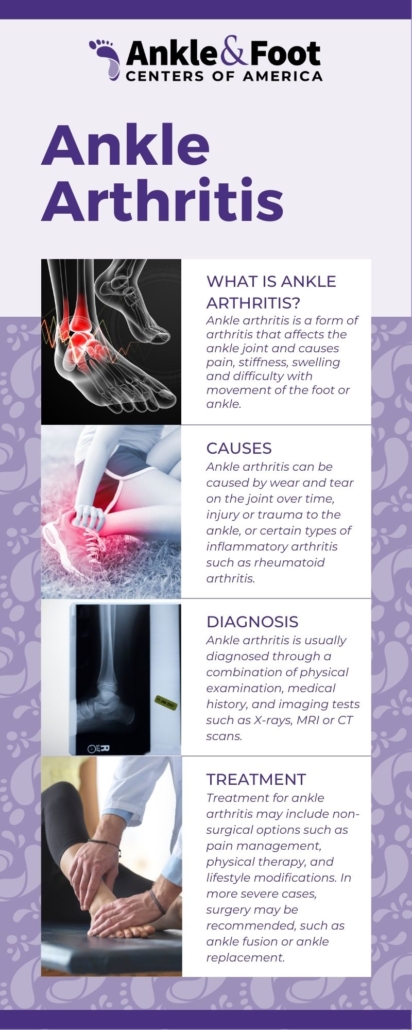Ankle arthritis can have a major impact on someone’s life, leading to discomfort and limiting mobility. To understand the different types of ankle-related arthritic conditions in order to effectively manage them is essential – this blog post covers how it’s diagnosed and looks at non-invasive as well as surgical treatment solutions for reducing pain while improving joint function.
Table of Contents
Key Takeaways
- Ankle arthritis is a condition that requires timely diagnosis and action to minimize the need for more invasive treatments.
- Comprehensive evaluation of the ankle joint by a medical professional is essential, along with lifestyle modifications, medications, assistive devices & bracing to reduce pain & improve mobility.
- Physical therapy plays an important role in rehabilitation and recovery from ankle arthritis.
Understanding Ankle Arthritis
 The joint located at the intersection between a person’s foot and leg can suffer from ankle arthritis, resulting in pain and swelling. This type of foot and ankle inflammation is characterized by breakdown or deterioration of the cartilage surrounding this spot on our anatomy. Swift detection is key to preventing extensive treatments like joint replacement surgery. There are three basic categories for this condition: osteoarthritis, post-traumatic arthritis, as well as rheumatoid, which each entail different treatments depending on their individual characteristics. The outer midfoot bone also has an essential role when it comes to understanding how one develops these ailments since disruption may result in hindering its functions with painful consequences that must be addressed accordingly.
The joint located at the intersection between a person’s foot and leg can suffer from ankle arthritis, resulting in pain and swelling. This type of foot and ankle inflammation is characterized by breakdown or deterioration of the cartilage surrounding this spot on our anatomy. Swift detection is key to preventing extensive treatments like joint replacement surgery. There are three basic categories for this condition: osteoarthritis, post-traumatic arthritis, as well as rheumatoid, which each entail different treatments depending on their individual characteristics. The outer midfoot bone also has an essential role when it comes to understanding how one develops these ailments since disruption may result in hindering its functions with painful consequences that must be addressed accordingly.
Osteoarthritis
Osteoarthritis, also referred to as degenerative joint disease, is a commonly observed form of arthritis that leads to the disintegration of cartilage in the ankle joint and brings about pain and stiffness. As this connective tissue deteriorates, bones begin rubbing against each other, which results in discomfort and swelling around the area – with continued neglect it can get worse over time. The risk factors include having a genetic disposition towards such conditions coupled with obesity while previous fractures or repeated sprains on your ankle may make one more vulnerable for developing inflammatory arthritis too.
It’s very important that preventive measures be taken quickly if osteoarthritis has been diagnosed so as to limit extra damage done within joints, decrease any agony felt, increase flexibility and mobility again when using said joint(s). Not taking action swiftly enough could lead to all these scenarios being far harder (or even impossible) to reverse due solely because extensive destruction had already occurred.

Rheumatoid Arthritis
Rheumatoid arthritis is an autoimmune condition that targets the ankle joint and may damage its bone, cartilage, ligaments and tendons. It differs from osteoarthritis, which develops with age. This type of arthritis happens when the immune system mistakenly attacks one’s own tissues, causing inflammation in or around a joint, specifically on your ankles. Over time, if untreated, it can cause deformation as well as limit activity due to disability resulting from deteriorating joints. While causes remain unclear, research suggests certain people are genetically predisposed. Environmental triggers such as infection could activate those genes initiating development of rheumatoid arthritis, making rapid diagnosis and treatment critical for maintaining healthy articular structures in these cases.
Post-Traumatic Arthritis
After an injury to the ankle joint, such as a dislocation or fracture that damages its surface, there is an increased risk of developing post-traumatic arthritis. Research suggests an injured joint’s chance of having this condition are seven times more likely than those without injuries. Taking prompt action can prevent Damage and alleviate pain while increasing mobility. Early detection during the initial stages should be prioritized for successful management, which could potentially delay major surgical procedures like arthroplasty on the affected area.
Diagnosing Ankle Arthritis
Accurately diagnosing ankle arthritis is essential for the most effective treatment strategy, as it involves a thorough evaluation of the joint. Evaluating one’s condition through physical examination and imaging tests will allow doctors to determine suitable ways to reduce pain levels and improve mobility in that area. Family physicians, rheumatologists or orthopedic surgeons can all provide an official diagnosis on cases of ankle arthritis in order to expedite proper care management.
Physical Examination
A physical examination of the ankle joint is essential for diagnosing arthritis in this region. The doctor will take into consideration swelling, discomfort areas, lack of flexibility and motion range during their evaluation. To examine these symptoms, they may ask about any prior medical history or traumas associated with the big toe and inner mid foot bone as well as other relevant information that could help reach an accurate diagnosis.
To Assess possible issues related to the ankle joint, a gait analysis can be performed by observing factors such as alignment of leg and foot bones, strength levels in feet and ankles. Assessing stride length etc. which all come together for an effective outcome when it comes time determine what condition one might have in order to offer treatment accordingly.
Imaging Tests
The diagnosis of ankle arthritis requires both a physical examination and imaging tests such as X-rays, MRI, CT scans or bone scans. Weight bearing X-ray images are particularly useful to evaluate the condition’s severity in terms of location and deformation on the joint. Blood tests may be recommended for illnesses like rheumatoid or inflammatory arthritis which involve different treatments than other kinds do. Through these diagnostic tools, physicians can decide what course of action is best when treating an arthritic ankle joint specifically tailored to each case.

Non-Surgical Treatment Options
For those who are in the early stages of ankle arthritis, there are various non-surgical treatments available to help reduce pain and improve mobility. This includes lifestyle changes such as diet modifications, medications that can be taken orally or topically applied, devices for additional support like braces and orthotics/assistive devices. All these treatments offer a way to manage symptoms of the condition while allowing individuals with treating their ankle arthritis an improved quality of life.
Lifestyle Changes
Weight loss can be beneficial for those suffering from ankle arthritis, as it lessens the amount of pressure placed on the joint. Low impact exercise activities such as cycling or swimming are helpful in maintaining a healthy weight and improving motion around the joints, which can reduce discomfort levels due to this condition. Modifications to any strenuous activity that may strain your ankle should also be made in order to prevent damage while alleviating existing pain sensations associated with it.
All these lifestyle adjustments have shown promising results when attempting to manage symptoms caused by arthritis of the ankles. Ultimately leading to an improved quality of life for individuals affected by it. Reducing stress through bodyweight control combined with restful alterations towards movements which could cause severe soreness go hand-in-hand, allowing one’s foot and joint area long lasting relief away from ache precipitated by movement challenges during regular tasks like running, standing up straight or even walking.
Medications
Pain management and inflammation reduction are key aspects of treating ankle arthritis that can be accomplished through the use of medications. Nonsteroidal anti-inflammatory drugs (NSAIDs) and corticosteroids are often prescribed to reduce swelling while providing pain relief for those suffering from this condition, allowing them more comfort in daily life activities.
It is important to follow a physician’s guidelines regarding medication usage as part of an overall plan for managing symptoms associated with ankle arthritis. When combined with other treatments such as lifestyle changes, drug therapy may delay or even prevent patients having to undergo joint replacement surgery.
Assistive Devices and Bracing
Orthopedic doctors may recommend assistive devices and braces to provide the ankle joint with stability, support and pain relief. Such items include shoe inserts or orthotics. Ankle-foot orthoses (AFOs), bracing for the ankles, as well as canes or crutches that work in order to help redistribute one’s body weight around both foot and anklet so that extra pressure is not being placed on an arthritic area. Using these objects everyday has been shown to allow people suffering from arthritis of their joints better manage daily activities while stopping any Damage taking place on said joints all while experiencing decreased discomfort levels at large!
Surgical Treatment Options
 For those not finding relief from non-surgical treatments, surgical options are an alternative to be considered. These interventions include arthroscopic debridement, ankle fusion (arthrodesis), and total ankle replacement. Each have different benefits and drawbacks based on the individual’s severity of arthritis.
For those not finding relief from non-surgical treatments, surgical options are an alternative to be considered. These interventions include arthroscopic debridement, ankle fusion (arthrodesis), and total ankle replacement. Each have different benefits and drawbacks based on the individual’s severity of arthritis.
What method is best for a given patient depends on what precisely their needs may be concerning this condition affecting the ankles. It is important to look into all available surgical treatment possibilities before making any decisions regarding these matters related to one’s health involving arthritis in conjunction with an affected joint such as the ankle area.
Arthroscopic Debridement
The goal of arthroscopic debridement is to ease pain and boost joint movement by taking out pieces of damaged cartilage or bone spurs in the ankle joints. This minor medical procedure makes use of a camera for viewing any affected structures, as well as specialized instruments that can take away debris from the targeted area while preserving whatever remaining cartilage still exists. The advantages are multiple: discomfort may be reduced, increased mobility within the joint is achieved, plus recovery time is shorter compared with traditional open surgical practices. People who have less severe cases of arthritis affecting their ankles could particularly benefit from this process since there’s an improved possibility for protecting existing cartilage materials present.
Ankle Fusion (Arthrodesis)
Arthrodesis, or ankle fusion, is a treatment for those suffering from arthritis in their ankles. This procedure merges two or more of the bones that form this joint together and limits movement between them to alleviate pain and inflammation. In doing so, it also provides stability within the ankle joint as well as long-term discomfort relief. There are some risks involved such as infection risk nerve damage plus an increased potential stiffness around the area post operation. Following surgery, patients typically follow physical therapy programs which help bring back mobility, allowing one to use their joints again at close capacity after arthrosis has set in.
Total Ankle Replacement
For individuals with advanced ankle arthritis, total ankle replacement may provide a solution to relieve pain and increase mobility. This procedure replaces the damaged joint of the ankle with an artificial implant designed to imitate natural movements for better range of motion than that offered by fusion surgery. It is necessary to consider all aspects when thinking about this type of operation, such as potential risks versus rewards depending on the severity level and needs unique to each individual patient before making any decisions.
Rehabilitation and Recovery
Physical therapy plays a key role in rehabilitating the ankle joint after arthritis treatment. Recovery timelines may be dependent on both how severe the condition is and what type of intervention was used, but should be discussed with healthcare professionals to best identify goals for rehabilitation success. Focusing on restoring function back into an arthritic ankle is essential and physical therapists can help set expectations around expected progressions over time.
Physical Therapy
Physical therapy is a critical part of ankle arthritis treatment and recovery. Through specifically tailored exercises and hands-on techniques, physical therapists are able to help individuals restore their functional movements, reduce pain levels, boost joint flexibility as well as increase the strength in their ankle joint. Physical therapists who provide these treatments are specialized healthcare professionals that can customize an individual’s plan according to needs and desired goals.
The timeline for such physical therapy depends on how severe one’s condition may be. There might also be variations due to the type of method employed – it normally takes several weeks up to months until its full effects show when talking about managing discomfort & level of activity improvements at both joints overall capacity levels gradually over time process occurrences.
Recovery Timeline
Recovering from ankle arthritis can take anywhere from a few weeks to multiple months, depending on the intensity of the condition, selected treatment method used, severity of the disease and overall health. To ensure an effective recovery process, it is important to follow doctor’s directions carefully while taking medications as prescribed. Including physical therapy sessions for your ankle plus getting adequate rest in order to avoid any injury during this period. Abstaining from activities that may bring harm will also contribute positively toward successful healing journey for those affected by arthritis around their ankles.
Summary
In summary, individuals with ankle arthritis often experience pain and difficulty moving. Early diagnosis is important to establish a successful management plan that could delay more extensive treatment such as joint replacement surgery. Options for managing this condition vary from non-invasive to surgical treatments each of which comes along with its own set of benefits and drawbacks. Committing oneself to an appropriate rehabilitation program can help in alleviating the arthritic pains experienced while aiding in improving overall quality of life.
Frequently Asked Questions
What does arthritis in ankle feel like?
Suffering from arthritis in the ankle can cause uncomfortable sensations such as aches, tenderness when touched and difficulty to move or support weight on it. Your joints may feel inflamed and swollen too. It is important not only for pain relief but also for mobility issues that are associated with having this condition to find an effective treatment soon after diagnosis.
What can be done for arthritis in the ankle?
Modifying activities, using bracing and compression, receiving corticosteroid injections, taking pain medications and anti-inflammatories, and undergoing physical therapy are all effective ways to manage arthritis in the ankle.
What are the first signs of arthritis in the ankle?
Pain in the ankle, decreased flexibility of movement, swelling around the joint and an audible popping noise may be among the first signs that one is experiencing arthritis in their ankle. Physical deformities such as bunions or hammertoe can appear due to this condition.
What causes ankle arthritis to flare up?
The ankle joint can be triggered to have an onset of arthritis if overexerted, affected by infection, dehydration due to lack of fluid intake or sudden changes in kidney function and when local trauma is experienced. Consuming too many high-purine foods may also cause a flare up of this condition affecting the ankle joint.
What are the most common types of ankle arthritis?
Arthritis of the ankle is a common condition, typically consisting of one or more forms such as osteoarthritis, rheumatoid arthritis and post traumatic arthritis.






